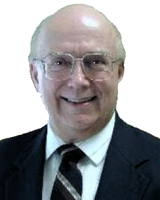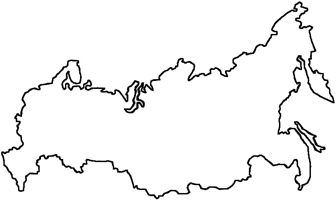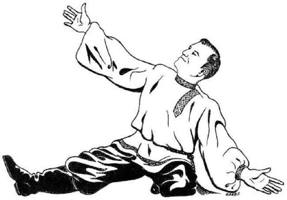
|
The Society of Folk Dance Historians (SFDH)
Folk Dances of Russia
[
Home |
About |
Encyclopedia | CLICK AN IMAGE TO ENLARGE |

|
 Under the significant sign of Union of Soviet Socialist Republics (USSR), which contains sixteen different republics, one can find many varied ethnic groups. This has come about through a long historical development of vast differences in background because of geographical, economic, and religious factors.
Under the significant sign of Union of Soviet Socialist Republics (USSR), which contains sixteen different republics, one can find many varied ethnic groups. This has come about through a long historical development of vast differences in background because of geographical, economic, and religious factors.
Throughout the history of Russia, interest in dance and music has been apparent. When one speaks about "Russian dance," he is referring ot the dances of Velikarussia or Great Russia, a geographical location in Central Russia.
All Russian dances basically have no fixed patterns. The setting of steps, the characteristics of one or another region or district is entirely free. The pattern is left to the inspiration and ability of the dancers. there is a typical, preferred dance form, however. It is a circle. The steps, expression of the dance, are related to the local tradition and style. The Horovodnaya Pliaska is the oldest Slavic dance formation. It has literally hundreds of variations.
- Buzz Step
The dancer turns CW, pushing off with the L toe on the up-beat (ct 6), and stepping approximately in the same place each time with the R ft, on the beat of the music (ct 1). Continue in the same rhythm for successive repetitions. When danced with a partner, use Square-Dance-Swing Position. - Pas de Basque (3/4,6/8, 2/4, 4/4 meter)
The step begins alternately on R and L ft. Example for starting on R ft:
3/4 2/4
Leap swd (or diag fwd) on R ft . . . ct 1 1
Step L ft in front of R ft . . . . . . . . . ct 2 &
Step bwd in place with R ft . . . . . . ct 3 2,4 - Push Step (2/4 meter)
If making the first of a series of "push steps" to the R, place the L toe swd, making a light pushing step (ct &); step swd R on R ft with a short "chugging" (An abrupt slide fwd, bkwd, or sdwd on either or both ft, usually accompanied by a plié of the supporting knee) step (ct 1). Continue in the same rhythm. Arm movements vary according to the nationality of the dance. - Russian Polka
This Polka step omits the hop on the up-beat, leaving "step-close-step:" Step (ct 1); close (ct &); step (ct 2); hold (ct &).
PRYSIADKAS
Russian and Ukrainian dances, with their squats, spins, and leaping steps, contain a unique quality of execution demanding the utmost of the individual in speed, balance, agility, and precision. The Ukrainian terminology for the squatting steps, "prysiadkas," signifies the physically challenging steps performed by the man only. "Prysiadkas" allow the man to flaunt his physical strength as much as the Spanish "Gitano" (Rom) amazes with his flurries of intricate footwork. While there are many variations of "prysiadkas" in both Russian and Ukrainian dances, those listed below are popularly used.
GENERAL ASPECTS OF PRYSIADKAS
- A straight, erect back in squatting position.
- A seeming ease in execution.
- Proper styling and precision in execution.
- Constant practice to develop the above qualities.
PRYSIADKA STEPS
- Heel Squat
- From a standing pos, assume a squatting pos – sit over heels and turn knees out. Hands cross in front of knees, palms turned in.
- Spring to astride pos, landing on the heels with toes turned up. At the same time, fling arms to an extended pos at shldr height.
Continue (a) then (b).
- Side Kick
- From a standing pos (heels together, toes turned out, R hand in back of neck, L fist on hip), assume squat pos. Assume standing pos by rising on R ft and kicking L ft directly to the L simultaneously.
Continue three times moving to the R and ending with a stamp L,R,L.
Repeat in opp dir, shifting pos of the hands.
- From a standing pos (heels together, toes turned out, R hand in back of neck, L fist on hip), assume squat pos. Assume standing pos by rising on R ft and kicking L ft directly to the L simultaneously.
- Pigeon Toe
- From a standing pos, assume a squatting pos.
- Recover to astride pos, landing on inverted toes – pigeon toed. The hands cross in front on the squat pos with palms turned in. In the astride pos, the hands are extended to the side opp the hips with palms turned out.
- Squat with Single Pigeon Toe
- From a standing pos, squat to heels – hands crossed between the knees with palms turned in.
- Assume astride pos, turning L toe to inverted pos, while R ft remains in normal pos. The R hand remains to the side with the palm turned in while the palm of the other hand is turned out.
Squat and repeat with R ft pigeon-toed and change in hand pos.
- Squat and Spin
- From a standing pos, squat to heels – hands crossed between knees with palms turned in.
- Land in astride pos on heels, hands extended swd at shldr height.
- Land in squatting pos (prepare), swing arms to the L giving the body momentum to spin to the L and rise on the L ft. In spinning once the R ft remains close to the L slightly off the ground.
Continue alternating Squat and Spin.
- Squat Toe Heel
- From a standing pos, squat over heels.
- Recover from squat to standing pos with L toe inverted, place L heel in same place..
Repeat sequence with the R ft.
- "Schupak" Heel Thrust
- From a squatting pos, knees almost together, arms folded over chest, thrust the R ft fwd at the same time sitting over the L heel.
Reverse and continue alternate thrusting.
A more difficult version of this step is to assume the same squatting pos, body balanced over the L heel while the R ft is thrust fwd off the floor.
Continue the above with alternate thrusts of R and L.
- From a squatting pos, knees almost together, arms folded over chest, thrust the R ft fwd at the same time sitting over the L heel.
- Leg Circling
- From a squatting pos, hands flat on floor in front, swing R extended leg swd and fwd, cutting our R arm which is immediately replaced, then similarly the L arm, and L leg, and assume original squatting pos.
R leg makes a complete cir.
- From a squatting pos, hands flat on floor in front, swing R extended leg swd and fwd, cutting our R arm which is immediately replaced, then similarly the L arm, and L leg, and assume original squatting pos.
DOCUMENTS
- Russian Dance and Music, an article.
- Russian Folk Dance
- Russia, a country.
- French Influences on Russia, an article.
Used with permission of the author.
This page © 2018 by Ron Houston.
Please do not copy any part of this page without including this copyright notice.
Please do not copy small portions out of context.
Please do not copy large portions without permission from Ron Houston.
